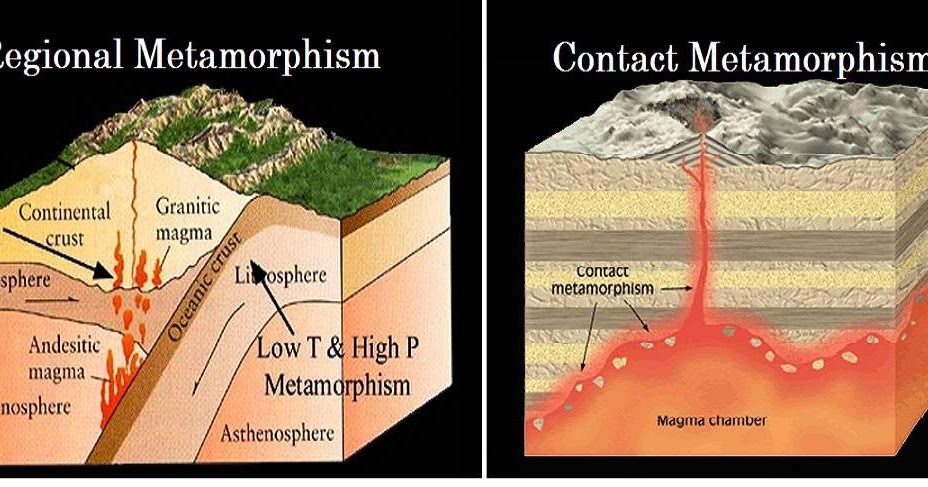Which of the Following Processes Will Cause Metamorphism
This is an example of. The pressure and heat that drive metamorphism result from which three forces.
2 What is the process that causes rocks to change composition when reacting with oxygen.

. Contact metamorphism involves intense heat while regional metamorphism involves high pressure. A change in the chemical environment B. Geothermal gradients in the earth caused by radioactive decay are the most common cause of temperature differences and thus a cause of metamorphism.
Clay minerals within a buried body of slate are recrystallized at high temperatures and pressures to form mica producing a rock called phyllite. Cementation of sediments O b. I and iii C.
An increase in pressureD. 4 Which of the following can cause physical weathering. The internal heat of the Earth the weight of overlying rocks and horizontal pressures developed as rocks become deformed The weight of the overlying rocks solar heating and nuclear fusion.
Iii and iv Explanation Thermal energy that causes metamorphism comes from two sources. Types of metamorphic processes. Which of the following processes will cause metamorphism.
The internal heat of the Earth the weight of overlying rocks and horizontal pressures developed as rocks become deformed The weight of the overlying rocks solar heating and nuclear fusion. Which of the following processes will cause metamorphism. It is normally produced by.
6 What happens abrasion. Stresses developed as rocks are deformed covalent bonding and heat released during rock crystallization. Ii and iii D.
The increase in temperature with increasing depth of burial d. During metamorphism changes in the bulk composition of a rock occur primarily as a result of _____. The pressure and heat that drive metamorphism result from which three forces.
Which of the following processes will cause metamorphism. Temperature Rock type Rate of deformation. All of the above are processes that cause lithification c.
3 Is Acid Precipitation an agent of physical weathering. This is an example of. Burial of sediments by deposition f.
The internal heat of the Earth the weight of overlying rock and stresses developed as rocks are deformed. Precipitation of dissolved ions onto clasts One. A change in the chemical environmentB.
The pressure and heat that drive metamorphism result from. Due to the increased rate of. Compaction of sediments What processes are involved in making.
An increase in temperatureC. A an increase in pressure B interaction with hydrothermal fluids C an increase in temperature D all of the above 8. 1 What Process Would Cause Increased Abrasion Along A Coastal Region.
Earth Sciences questions and answers. In regional metamorphism the source of increased temperature and pressure is a. The three main types of metamorphism are.
Which of the following does NOT cause metamorphism circle best answer. A buried body of shale is subjected to differential stress causing clay minerals to realign and produce slate. Contact also known as thermal metamorphism.
Heat that comes from Earths hot springs. I and ii B. This is produced by high temperature low pressure low strain and variable fluid pressure.
The types of metamorphism are contact regional cataclastic hydrothermal burial and shock metamorphism. Heat that comes from the Earths geothermal gradient. Which of the following processes will cause metamorphismA.
An increase in pressure D. Low grade metamorphism of sediments d. As temperature andor pressure increases old minerals may change typically they increase in size or new minerals may form.
First is the heat that comes from ascending magmas as in the case of contact metamorphism. An increase in temperature C. There are two main factors that can cause the conversion.
All of these 2. A an increase in pressure B interaction with hydrothermal fluids C an increase in temperature D all of the above. A local intrusive heat source b.
An increase in pressure an increase in temperature interaction with hydrothermal fluids all of the above Temperature rate of deformation and rock type What determines whether a rock deforms in a brittle fashion versus a ductile fashion. 5 What is an agent of mechanical weathering. The weight of overlying rock solar heat and nuclear fusion.
Lowering of temperature high tide. The presence of hydrothermal fluids at the time of transformation can also play a role in the resulting rock. All of these factors vary widely and result in different types of metamorphism depending upon which factor is dominant.

Contact Metamorphism Vs Regional Metamorphism

Geology In Contact Metamorphism Vs Regional Metamorphism Geology Metamorphic Rocks Metamorphic Rock Formation

Powerpoint Metamorphic Rock Metamorphic Rocks Metamorphic Technology Lessons
Comments
Post a Comment